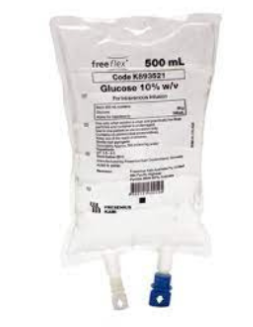
(Baxter) Glucose 10% w/v Price
Active Substance: Glucose.
Overview
Welcome to Dwaey, specifically on (Baxter) Glucose 10% w/v page.
This medicine contains an important and useful components, as it consists of
Glucoseis available in the market in concentration
Name
Glucose
Precaution
<p>Use glucose with caution in patients with diabetes mellitus, hyperglycemia, or known glucose-galactose malabsorption. Caution is also advised in patients with renal impairment, cardiac decompensation, or electrolyte imbalances, particularly hyponatremia or hypokalemia. Monitor blood glucose levels frequently during intravenous administration to avoid hyperglycemia, especially in neonates and critically ill patients. Ensure appropriate dilution and infusion rate to prevent fluid overload or osmotic diuresis.</p>
Indication
<p>Glucose is indicated for the treatment of hypoglycemia, dehydration with carbohydrate depletion, and as a carbohydrate source in parenteral nutrition. It is also used to provide calories in intravenous solutions, treat insulin-induced hypoglycemia, and support patients unable to maintain adequate oral intake. In some diagnostic tests, such as the glucose tolerance test, it serves as a test agent.</p>
Contra indication
<p>Glucose administration is contraindicated in patients with hyperglycemia, glucose-galactose malabsorption syndrome, or known hypersensitivity to glucose. It should not be used in patients with severe dehydration without electrolyte replacement, uncontrolled diabetes mellitus, or intracranial or intraspinal hemorrhage (when large volumes of hypotonic solutions are involved). Avoid use in patients with anuria or severe renal impairment without adequate monitoring.</p>
Side Effect
<p>Common side effects include phlebitis or irritation at the infusion site, hyperglycemia, and osmotic diuresis. High concentrations or rapid infusion may lead to electrolyte imbalances, dehydration, or pulmonary edema. Rare but serious adverse effects include fluid overload, especially in patients with compromised cardiac or renal function. In neonates, excessive glucose can lead to intraventricular hemorrhage or retinopathy of prematurity.</p>
Pregnancy Category ID
Information not available
Mode of Action
<p>Glucose is a monosaccharide and a primary energy source for body tissues, especially the brain and red blood cells. When administered intravenously, glucose is metabolized via glycolysis and oxidative phosphorylation to produce ATP. It replenishes blood glucose levels, supplies immediate energy, and spares protein and fat metabolism during caloric deficiency. Glucose also plays a critical role in maintaining osmotic balance in IV fluids.</p>
Interaction
<p>Glucose may interact with insulin and oral hypoglycemic agents, reducing their efficacy if administered inappropriately. Co-administration with corticosteroids or diuretics may influence fluid and electrolyte balance. The presence of high glucose levels may interfere with certain laboratory tests, including those measuring serum electrolytes or glucose oxidase-based assays. Concurrent use with potassium-free solutions may exacerbate hypokalemia.</p>
Pregnancy Category Note
<p>Glucose is generally considered safe during pregnancy (FDA Pregnancy Category: Not formally assigned). It is commonly used during labor and delivery for maternal hydration and energy. However, careful glucose monitoring is recommended in pregnant women, particularly those with gestational diabetes or other metabolic conditions, to avoid maternal and fetal hyperglycemia or metabolic complications.</p>
Adult Dose
<p>The typical adult dose depends on the indication. For hypoglycemia, 25–50 ml of Dextrose 50% solution IV push may be used. For maintenance therapy or caloric supplementation, glucose solutions (e.g., 5% or 10%) may be administered at controlled rates (e.g., 2–3 liters/day), adjusted based on caloric needs and fluid status. Dosage must be individualized based on clinical condition, blood glucose monitoring, and hydration status.</p>
Child Dose
<p>In pediatric patients, the dose should be carefully calculated based on age, weight, and clinical condition. For neonates with hypoglycemia, 2–5 ml/kg of Dextrose 10% IV bolus may be given, followed by continuous infusion. In older children, Dextrose 25% or 50% may be used at doses of 0.5–1 g/kg. Continuous monitoring of blood glucose and fluid balance is critical to avoid complications.</p>
Renal Dose
<p>No specific dosage adjustment is generally required for glucose in renal impairment; however, caution is warranted due to the risk of fluid overload and electrolyte disturbances. Monitor blood glucose, renal function, and electrolyte levels closely in patients with renal insufficiency, especially when large volumes or high-concentration solutions are used.</p>
Administration
<p>Glucose is administered intravenously, either as a bolus (for acute hypoglycemia) or as a continuous infusion (for maintenance or nutritional support). Solutions like Dextrose 5% or 10% are commonly used in IV fluids. Ensure proper aseptic technique during administration. Infusion rate should be carefully regulated to avoid complications such as hyperglycemia, fluid overload, or electrolyte imbalance.</p>
